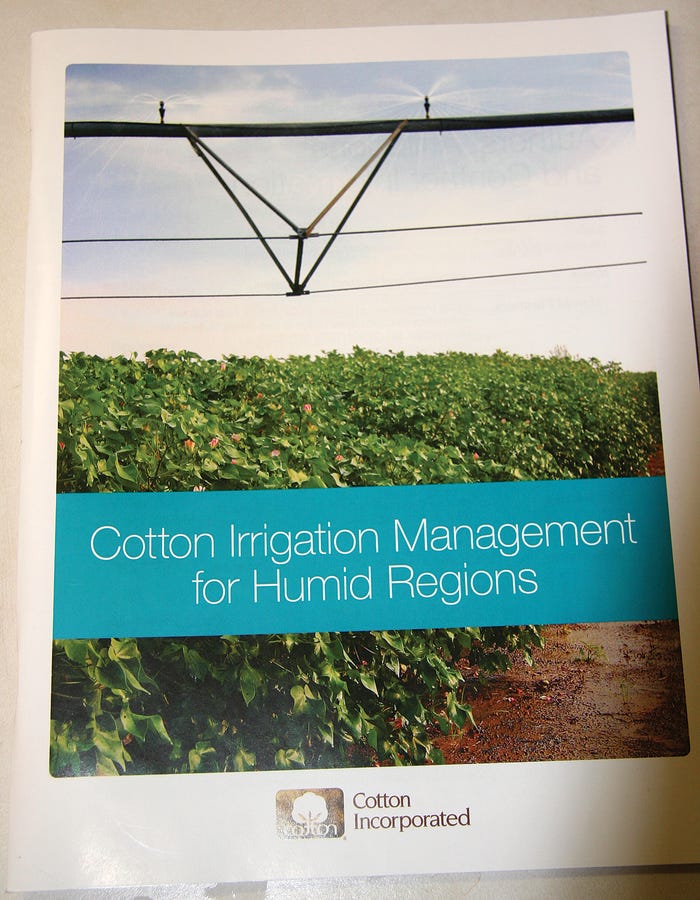December 7, 2012

Ed Barnes bristles when someone criticizes cotton farmers for using too much water.
Barnes, the director of agricultural and environmental research for Cotton Incorporated, says he used to respond, defensively, that only 36 percent of the cotton grown in the United States is irrigated.
“That might make it sound like irrigation is a bad thing, and it’s not,” he told consultants attending Cotton Incorporated’s Crop Management Seminar in Tunica, Miss. “So now I’m trying to get the message out that irrigation is part of a sustainable production system.”
Once farmers put down their planting seed and their starter fertilizer, and it doesn’t rain, he said, “that’s not a very good environmental impact and that’s not a very good use of land resources. So irrigation gives us that stability and prevents us from wasting all the other inputs that we invest in early in the season.”
Barnes was the moderator for the Precision Irrigation Workshop that followed the biennial Crop Management Seminar that Cotton Incorporated has organized for crop consultants and other ag professionals in recent years.
He also introduced a new book titled Cotton Irrigation Management for Humid Regions, a Cotton Incorporated publication that provides information on many aspects of irrigation, including getting the “most crop per drop.”
Besides helping growers stabilize yields, the precision management techniques included in the book are aimed at helping conserve water and prepare for the possibility of increased regulation of water use.
“Even here in Mississippi, we’re seeing threats of regulation,” Barnes noted. “In Georgia, they’re installing pump meters. Even in the humid areas, we’re seeing this. If we step forward and show that we are using the best technologies to manage our water, I hope that will prevent increased regulation.”
Irrigation varies widely across the United States with almost all crops in the arid West receiving some form of irrigation. Some may be surprised to learn, however, that Arkansas ranks No. 2 in irrigation water produce due, in part, to the large amount of rice acres in the state.
Chris Henry, an Extension agricultural engineer with the University of Arkansas, is working with producers in the row crops areas of the state, to try to help them make sure they’re getting the most out of each gallon of water they pump.
Henry, who also spoke at the Precision Irrigation Workshop, has been using pump monitors to measure flow, pressure and energy usage by farmers.
“Arkansas uses about 7.2 billion gallons of water per day with about 76 percent of that used in agriculture,” he said. “Only about 46 percent to 47 percent of that is sustainable. We need to reduce our water use by half.”
Surprisingly, Arkansas growers may face a bigger challenge in managing irrigation than their counterparts in the West.
“It’s actually easier to manage irrigation in states like Arizona where you receive less than 10 inches of rainfall per year,” said Barnes, who worked in the state for seven years. “You pretty much know you’re going to have to irrigate, and there are no compounding factors.”
As you move east, you get more rainfall. But even in those areas that receive 50 to 60 inches of rainfall per year, it may not fall at the right time, and odds are it won’t all stay in the fields where you need it.
“When you get a 5-inch downpour, how much of it actually stayed on the field?” he asked.
As you move west to east and look at the irrigated acres in the United States, the amount drops significantly once you leave Arizona and New Mexico. Less than 40 percent of the cotton acres in Texas, Oklahoma and Kansas are irrigated.
“I found it interesting that 80 percent of the acres in Arkansas are irrigated,” he said. “After you get past Arkansas, the number dropped off when this survey was taken in 2007. But now we’re seeing a lot of systems going in in states like North Carolina and South Carolina.”
There’s no doubt irrigation pays. Studies have shown that an acre inch of water can mean another 50 pounds of lint for producers. “So if you miss a couple of irrigations that you should have made that’s 100 pounds of yield that you lost.”
About the Author(s)
You May Also Like






